Hi Ho Silver! -- The Lost Chalice
Hi Ho Silver! -- The Lost Chalice
By Suzan Mazur

Click to enlarge
Euphronios male figures - Sarpedon cup (520 BC) (left) and female figures(505 BC) (right)
Yes, there was a 1955 Lone Ranger episode called "The Lost Chalice" about a chase for
escaped convicts and a treasure. And if you’re a Spaghetti
Western fan, you might like the HarperCollins version of the
book by the same name with its "Cast of Characters" by
Bloomberg News Rome correspondent Vernon Silver.
It’s about Silver’s quest to find the Euphronios
Sarpedon cup, the “twin” of the Euphronios bowl the
Metropolitan Museum of Art denied for 33 years (or so) came
from Italy but returned to Italy in 2008. Sotheby’s sold
the "twin" at auction June 19, 1990 for Texas oil man Bunker
Hunt.
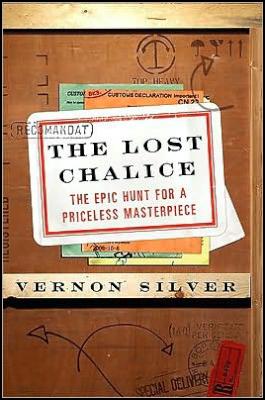
Hunt originally purchased the cup from Rodeo Drive dealer Bruce McNall, who got it from Roberto “Bully Bob” Hecht, who bought it from now-convicted dealer Giacomo Medici, who bought it back for $742,000 with a pedigree from Bunker Hunt via the 1990 Sotheby’s sale Silver calls the “auction of the century.”
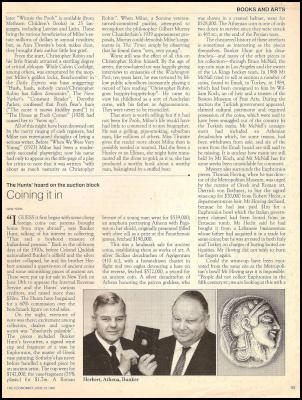
Click to enlarge
Suzan Mazur's 1990 Economist magazine coverage of the Hunt-Sotheby's auction
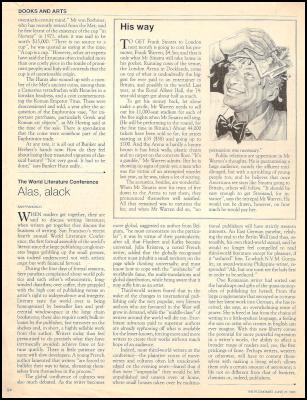
Click to enlarge
A rose-colored spotlight is on the desperados in Vernon Silver's tale of The Lost Chalice with the Italian lawyers and Carabinieri art squad in pursuit as Lone Ranger, Tonto and the posse.
However, the book gets off to a dusty start with the following astonishing claim about the kylix or cup in the prologue: “Its whereabouts are an art world mystery Until now.”
UNTIL NOW? Silver and I each reported in 2005 that the Sarpendon cup was in pieces in a box in the Villa Giulia museum after being dropped by the police during a raid on Medici’s warehouse. Moreover, my story referring to this was included in Harvard Law School’s 2008 curriculum along with 14 related articles of mine.
Here’s an excerpt from that December 6, 2005 story about the kylix being at Villa Giulia, with an email to me from former Met director Tom Hoving proposing that there was a second Sarpedon Euphronios cup. Hoving emailed both Silver and me on December 5, 2005, not just Silver. I didn't act on Hoving's tip because I didn't believe it:
"Former Metropolitan Museum Director Tom Hoving has just emailed me saying he believes there were three depictions of Sarpedon by Euphronios and says former Met Greek and Roman curator Dietrich von Bothmer agrees. They cite the pieced together wine cup purchased at the Hunt-Sotheby’s auction by art dealer Giacomo Medici as one; it’s now in even tinier pieces in the Villa Giulia museum in Rome. Another cup Hecht presented by way of a photo to the Met in 1973. And, of course, the Met’s complete Euphronios vase. Hoving writes:
“Kiddo, I called the guy who was with me when bobbie h. [Hecht] showed the photo of the early sarpedon – dietrich von b [Bothmer]. I asked what he recalled seeing and he said exactly what I remembered, a Euphronios cup with Sleep and Death marching to the right with Sarpedon’s body on their shoulders like some log of wood. My eye doesn’t forget, it seems...""
Also, I’ve interviewed Italy’s antiquities lawyer Maurizio Fiorilli, a tireless champion of his country's cultural heritage. Silver lists Fiorilli last in his "Cast of Characters", after all the diggers, dealers and acquisitors. But Fiorilli is for real, clearly not a canned-in-Hollywood character. He rightly went to the American media with his concerns and was successful. "Until now we have dreamed, we have slept. Now it is time to wake up," he told the Los Angeles Times. He once shared his honest view of the Metropolitan Museum of Art with me -- “THIEVES!”
Here’s a glimpse of some of Silver's other special effects -- from his imaginary vision of me wide-eyed and holding the Euphronios cup on June 4, 1990 at the Hunt-Sotheby’s auction preview, a scenario he gives two pages in the book:
“The unexpected and rare treat unnerved the journalist. Her skin would touch the same surface Euphronios’s had, the same surface the Etruscans had handled and tomb robbers and smugglers had passed their fingers over. This cup had ruined Dietrich von Bothmer’s archaeology career and made its way from Robert Hecht to Bruce McNall to Bunker Hunt. . .”
I asked archaeologist and Met Ancient Near East scholar Oscar White Muscarella about von Bothmer's "ruined" archaeology career. Muscarella's courageous criticism of the acquisition of the Euphronios bowl by the Met gets several pages in the prologue of Peter Watson's Medici Conspiracy book Muscarella gets an anonymous two-paragraph cameo in the Silver book. He emailed me saying this:
"You showed me Vernon Silver’s phrase: “This cup had ruined Dietrich von Bothmer’s archaeology career. . . .” because after presenting the slide of the cup at the 1972 year-end meeting of the AIA he lost the vote to be elected as one of its trustees. (I with others got him defeated.)
First, Bothmer had/has no “career in archaeology”—because he never was an archaeologist; and second, because everything he has ever done as a museum curator is contra archaeological responsibilities and spirit. And his aristocratic and billionaire background allowed him to successfully accomplish anything he wanted to do at the MMA, including ruining fellow employees."
Vernon Silver credits me with inspiring his book-length quest for the chalice, saying he had “no idea” that the cup existed prior to my email to him about it. Lovely. So why was my request ignored when I asked -- while the book was still in galleys -- for a correction to copy that suggests I was courted by Sotheby’s “to build the hype and boost the sale” of the Hunt-Sotheby’s auction?
Nothing could be further from the truth. As an independent journalist I’d been addressing antiquities looting in a series of Economist articles – beginning in 1987 with a story about the Lydian Hoard.
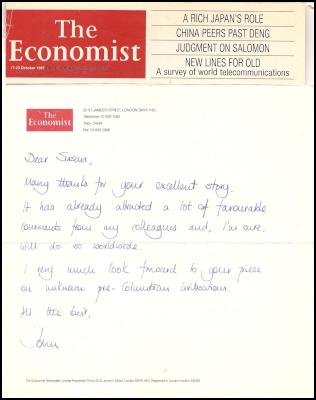
Click to enlarge
October 1987 letter from Economist Arts Editor John Parker to Suzan Mazur about the Lydian Hoard story
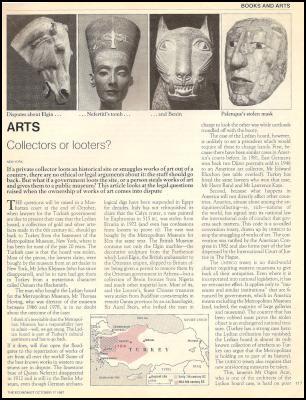
Click to enlarge
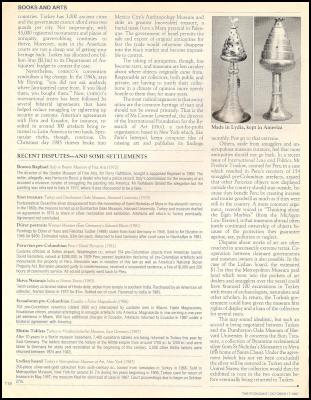
Click to enlarge
And while the New York Times, the other news organization Silver cites reporting the auction, was indeed in the business of promoting the sale of ancient art – I was standing inside the auction ropes alongside Turkish journalist Ozgen Acar. Acar with Melik Kaylan wrote two pivotal antiquities exposes for Connoisseur magazine. I collaborated with Acar on another two stories for Connoisseur and spent part of the morning of June 19 with him at Bob Hecht’s New York gallery getting the “lowdown” from Hecht and his financier Jonathan Rosen about the Hunt-Sotheby's sale, which Silver knows from reading my series syndicated by Scoop Media (2005-2008).
There is no mention of Ozgen Acar in Silver's book, although Acar has for decades been one of the most incisive journalists covering the illicit art trade. If Silver had interviewed him, he might have been able to share with readers who the Turkish dealer was who sold the Sabina marble statue to Hecht from the "impressive haul" in his warehouse in Munich. The Sabina eventually wound up at the Boston Museum of Fine Arts where Italy's lawyer, Maurizio Fiorilli negotiated for its return to Rome in 2006.
Acar has emailed me from Turkey saying it's likely it was Fuat Uzulmez of Munich's Artemis Gallery. Uzulmez is the handsome playboy who escorted me out of the Hecht- McNall Park Lane Hotel auction in November 1990, putting his arm around me and whispering in my ear: “We are going to kill him [Acar].” Hecht's daughter knew him as "Uncle Fuat".
Silver argues that antiquities looting is systemic, citing the involvement of institutions such as the Met, Oxford University – where the antiquities trade did their thermoluminescence testing on objects – and Sotheby’s (he leaves out the IRS, which got the lion’s share of the $20 million from the Hunt antiquities sale and the US Justice Department, which enabled creditors to get their piece, and of course, the banks). But he appears sympathetic in his treatment of the most controversial figures.
Silver tells us that Medici was born into an antiquities looting way of life (like a polygamist being born into a polygamy family?) and says his family found hardship when Mussolini made all ancient artifacts found on Italian soil state property in 1939. He then presents Medici as a casualty of WWII Allied bombing. Later there is attention to Medici's prostate surgery.
He similarly recounts the "grave danger" to von Bothmer's life, his leaving Europe for New York (on the Queen Mary) in 1939 and enlisting as a private in the US Army only to get hit in both legs behind enemy lines fighting the Japanese in Dutch New Guinea. And Hecht serving his country as an interpreter during WWII. No mention of Hecht assaulting me and others.
To quote from my January 20, 2007 interview with Bob Hecht’s former Rodeo Drive partner Bruce McNall – who I also introduced Silver to by way of his home telephone phone number:
"When he [Hecht] was drinking he would get a little bit more testy and violent and upset about things. He never did anything to me per se. But when people would argue with him about something or he got upset, he definitely had a temper. It doesn't surprise me that he took a punch at you."
McNall told me this regarding Tom Hoving:
"The funny thing about Tom Hoving is he rants on about all these horrible things yet he knew everything – to my knowledge – from day one."
And this regarding the origin of the
Euphronios pieces:
"Suzan Mazur: Can
you tell me what you know about the origin of the signed
Euphronios vases Sotheby's auctioned for the Hunts? You say
in your book that "They [the Hunts] even bought their own
pieces by Euphronios, a krater and a kylix. Both were
obtained through Bob Hecht and bore the shadows that all of
Hecht's items carried."
You said you sold the Sarpedon Euphronios cup to Bunker Hunt for about $1 million and that it was probably purchased from the same tombaroli who supplied Hecht's Sarpedon Euphronios krater. Can you be more specific? Did Hecht ever tell you the real story behind the origin of the Sarpedon Euphronios krater?
Bruce McNall: Not really. It was the one area during the entire course of the partnership he would avoid. Having said that, I always felt that it came from Medici. That was my assumption.
Suzan Mazur: The Sarpedon krater and Sarpedon kylix.
Bruce McNall: Right. The krater and the kylix. . . ."
And, there’s a distortion of how the Hunt sale actually unfolded. Silver writes “But the Euphronios chalice was the pint-sized star of the auction.”
All eyes were not on the Euphronios pieces. Silver wasn’t at the Hunt sale and did not interview a cross-section of those in attendance or, I gather, even read NYT reporter Rita Rief’s June 15, 1990 story. Rief put it like this:
"Among the most important offerings is one of the largest Roman bronze figures ever auctioned, a 45-inch standing youth from the second century B.C., expected to bring $800,000 to $1.2 million. Notable, too, are the two ancient Greek vessels by the vase painter Euphronios. . "
Around the time of the auction I did interview Bunker Hunt, Boston Museum of Fine Arts classical curator Cornelius Vermeule, dealers Joel Malter, Andre Emmerich, Arnold Sasslow and others. Weeks before the sale I also spoke with Ed Merrin (who bought 10 pieces at the Hunt sale) for an Economist story and with his financier Asher Edelman (inspiration for Wall Street's Gordon Gekko).
The most expensive piece on the block was the Roman bronze boy, which had been exhibited by the Met, MFA, Kimball Art Museum and others. During our pre-auction interview Vermeule told me, “I’d estimate it goes for $1.5 to $2 million.” Vermeule’s favorite piece though was the Medea vase – “I’d kill for #14,” he said.
Hecht thought the Zeus head would go for $1 million.
Some were looking to the coins. The Athena coin was chosen as the visual for my Economist story, even though Arnold Sasslow advised:
"The one [Athena decadrachm] that sold for $480,000 is far inferior to the decadrachm hoard from Turkey which have sold for $250,000 [each]."
A point Hecht made at his gallery that morning.
The cover of the auction catalogue featured a drinking cup attributed to Epidromos with a naked hunter holding a spear and wearing a hat. That cup would resurface in October 2006 on Madison Avenue at the Aboutaam brothers’ sale (an event the New York Times was paid over $20,000 by the Aboutaams to advertise).
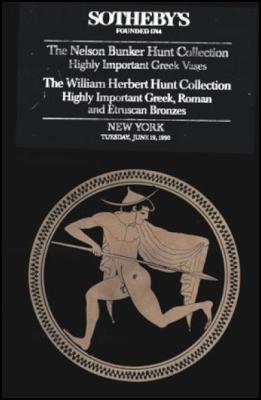
Click to enlarge
Too much of Silver's book simply recycles the old Euphronios stories of Tom Hoving (Silver has an entire chapter about the Euphronios bowl called The "Hot Pot", referring to Hoving's series by the same name), Nicholas Gage, John Hess, Bruce McNall, Peter Watson, Archaeology magazine and mine.
What is enlightening in Lost Chalice is the information Silver shares from his original reporting in June 2008 at the Euphronios krater dig site with "the last known surviving member of the tomb-robbing gang". His presentation of the Sarpedon mythology, Euphronios painting technique (no mention of his innovation in depicting female nudes though) and Beazley method of recording vases is inspired.
 Suzan Mazur's stories on art and antiquities have been
published in The Economist, Financial Times, Connoisseur,
Archaeology (cover) and Newsday. Other reports have appeared
on PBS, CBC and MBC. She has been a guest on McLaughlin,
Charlie Rose and various Fox Television News programs.
Email: sznmzr@aol.com
Suzan Mazur's stories on art and antiquities have been
published in The Economist, Financial Times, Connoisseur,
Archaeology (cover) and Newsday. Other reports have appeared
on PBS, CBC and MBC. She has been a guest on McLaughlin,
Charlie Rose and various Fox Television News programs.
Email: sznmzr@aol.com


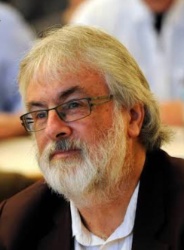 Ian Powell: Trumpian Health Leadership
Ian Powell: Trumpian Health Leadership Eugene Doyle: Disruption - Historians Challenge Russophobic Propaganda
Eugene Doyle: Disruption - Historians Challenge Russophobic Propaganda Ramzy Baroud: War, Doublethink, And The Struggle For Survival - Geopolitics Of The Gaza Genocide
Ramzy Baroud: War, Doublethink, And The Struggle For Survival - Geopolitics Of The Gaza Genocide Binoy Kampmark: Authoritarian Politics - Netanyahu’s War On Israeli Institutions
Binoy Kampmark: Authoritarian Politics - Netanyahu’s War On Israeli Institutions Keith Rankin: Learning The Correct Lessons From World War Two In Europe
Keith Rankin: Learning The Correct Lessons From World War Two In Europe Ramzy Baroud: Arab Failures - The Unspoken Complicity In Israel's Genocide
Ramzy Baroud: Arab Failures - The Unspoken Complicity In Israel's Genocide